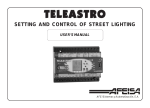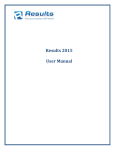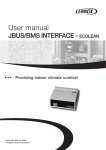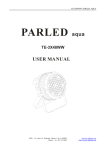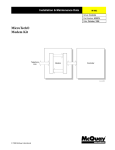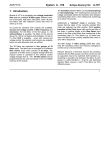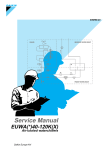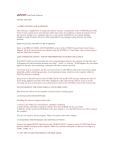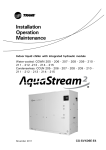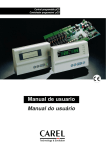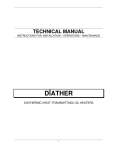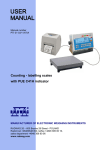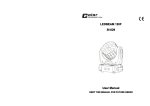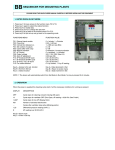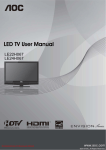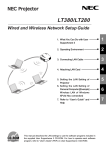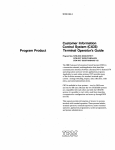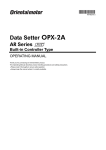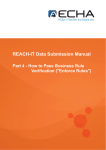Download SEQUENCE CONTROLLER Carel SEQ3.04 User manual
Transcript
SEQUENCE CONTROLLER Date: SEPT, 2003 Replaces: 506B-01/04B User manual Programme code: Ref: SEQ3.04 TABLE OF CONTENTS 1 OPERATING LIMITS………………………………………………………………………………………………………...C 1 FEATURES OF THE PROGRAMME ...........................................................................................................................0 2 USER INTERFACE ........................................................................................................................................................0 2.1 2.2 2.3 2.4 2.5 2.6 KEYBOARD-DISPLAY TERMINAL: FRONT PANEL VIEW WITH FRONT DOOR CLOSED ..............................................................0 SILICONE RUBBER EXTERNAL BUTTONS .........................................................................................................................0 FRONT VIEW WITH FRONT DOOR OPEN ...........................................................................................................................1 USE OF THE BUTTONS ..................................................................................................................................................1 DISPLAY.....................................................................................................................................................................2 FUNCTION INDICATOR LEDS ........................................................................................................................................2 3 LIST OF PARAMETERS ...............................................................................................................................................3 4 ALARM DESCRIPTION................................................................................................................................................9 5 DESCRIPTION OF PARAMETERS............................................................................................................................10 6 CONNECTIONS ...........................................................................................................................................................19 6.1 6.2 7 HARDWARE ARCHITECTURE .......................................................................................................................................19 MAIN BOARD - LAYOUT.............................................................................................................................................20 MEANING OF INPUTS AND OUTPUTS....................................................................................................................22 INSTALLATION OF EPROMS..................................................................................................................................................24 8 CONNECTION OF OPTIONAL BOARDS..................................................................................................................24 8.1 8.2 9 SERIAL PRINTER ........................................................................................................................................................24 CLOCK BOARD ..........................................................................................................................................................24 APPENDIX A: TROUBLESHOOTING .......................................................................................................................25 OPERATING LIMITS The McQuay sequencer is capable of controlling a system of Chillers or Heat Pumps, installed in a single system, in order to control the common leaving water temperature of the evaporators, for improved and complete system management. The McQuay sequencer can control up to a maximum of 10 units installed in a single system, The control point is a temperature probe installed in the common leaving water pipe from the units, reference ELWT (Evaporator Leaving Water Temperature) The McQuay sequencer also has a second temperature probe CWTR (Cooling Tower Water Return) capable of controlling the cooling tower steps in the case where some water-condensed refrigerators are installed in the system (series WHR, WHS, PFS, WHZ, PEH, PFH, WSC, WDC). In the case where a CTWR probe is installed, the number of units which can controlled is limited, The sequener can only control a maximum number of 10 devices. Example: a) b) c) d) Up to 10 air-cooled units (ALS, ALR, AGR, ALZ) without any added control requiring the use of digital outputs. In the case where cooling tower control is required, the maximum number of units controlled cannot exceed 10 minus GT, GT being the number of Tower Steps to be controlled. In the case where cooling tower control by inverter is required (without added On/Off steps), the maximum number of units controlled is 10. In the case where control of a bypass valve on the cooling circuit is required, as well as tower step control, the maximum number of units that can be controlled is 10 minus GT, GT being the number of Tower Steps to be controlled. The system also permits the following functions: 1) Setpoint Reset: With an external signal of 4-20mA, it is possible to vary the system’s cooled water control setpoint. 4mA relates to the minimum setpoint value (St3) and 20mA relates to the maximum setpoint value (St4). A value below 4mA disables this function. 2) Load limiter: With an external signal of 4-20mA, it is possible to limit the number of refrigerators in terms of limiting electrical absorption at certain periods of the day. The number of units set will be subdivided proportionally in terms of the external signal set. The system divides the difference between the maximum and minimum signal (20-4 = 16 mA) by the number of refrigerators set in the controller and the enables/disables for each increase in signal sent. eg.: for 8 refrigerators set, we have 16mA : 8= 2mA/refrigerator. Every 2 mA enables or disables a refrigerator. 3. Ambient compensation: With the installation of an ambient sensor, it is possible to vary the setpoint of the cooled water in terms of external air. This option allows an energy saving in low-load periods. 1 FEATURES OF THE PROGRAMME The programme allows full management of a refrigerator plant consisting of several refrigerators. The features of the system are as follows: display and control of the measured sizes; possible configuration of the number of refrigerators to be controlled; LED display of alarms and their audible signals by means of a buzzer; programming of the configuration parameters and of some operational parameters with access protected by a password; modification of the basic operating parameters (setpoints, differentials, alarm thresholds, timers); LED display of the active functions; printout of the alarms detected and, at intervals, the state of the main variables of the machine; by time band programming it is possible to operate the devices controlled by probe 1 from a second setpoint (secondary) so as to save energy during the programmed hours and days; - connection to a supervisory/remote controlled assistance serial line according to RS422/RS485 standard and Carel’s communication protocol. 2 2.1 USER INTERFACE Keyboard-display terminal: front panel view with front door closed Figure 1 references COMPRESSORS Bar Bar °C °C °F °F FANS SET 2 SET EXT 1. 2. 3. 4. External function-indicator LEDs Rubber external buttons LED display Front window NETWORK Figure 1 2.2 Silicone rubber external buttons Figure 2 References Figure 2 1. On/off button: turns the unit on and off. When the unit is on, the LED button is lit (a green colour) - an unlit LED indicates that the unit is OFF; - a flashing LED indicates that the unit has been turned off by a supervisor or by remote control, by means of a digital input; 2. Alarm button: it is used to display the alarms, to reset them manually and to silence the buzzer. If the button is lit (red), it means that at least one alarm has been detected. 3. The arrow pointing upwards sets the values of the control parameters (not back lit), or to disable manual procedure. 4. The arrow pointing downwards sets the values of the control parameters (not back lit), or to disable manual procedure. 5. Enter button: to scan the messages on the display. The button is continuously lit (yellow light) and indicates that the power is On. 2.3 Front view with front door open Figure 3 references COMPRESSORS Bar Bar °C °C °F °F FANS 1. 2. 3. 4. SET 2 SET EXT NETWORK Polycarbonate - coated mechanical buttons Function indicator LEDs Adhesive polycarbonate Silicone rubber buttons. Figure 3 2.4 Use of the buttons permits display of values detected by the probe ELWT (cooled water) and by probe CTWR (cooling water) permits access to the values related to the hour counters, to the manual procedure of the devices connected and to probe setting gives access to the set of parameters for operating the printer (where required) permits display of the status of inputs and outputs, both digital and analogue permits display/programming of the clock (if present) and of related time bands with setpoint variation permits display and setting of the setpoints permits setting of the various operating parameters (protections, thresholds), as well as the parameters relating to unit configuration permits display of the version of the programme to be applied The LEDs beside the listed buttons light up when pressed, and remain in this status until any one of the above-mentioned buttons is pressed. 1 2.5 Display COMPRESSORS Bar Bar °C °C °F °F FANS SET 2 SET EXT NETWORK Figure 4 Features • number of digits: 6 • colour: green • height: 13mm • number of side indicator LEDs: 5 • number of LEDs indicating the displayed function: 3+3 2.6 Function indicator LEDs The 5 LEDs placed beside the display have the following meaning: 1. LED On at least one refrigerator, controlled by probe ELWT, is enabled; Flashing LED at least one refrigerator, controlled by probe ELWT, is in waiting phase, meaning that its operation has been requested, but it remains off until its internal timers have been elapsed; LED Off no refrigerator, controlled by probe ELWT, is enabled; 2. LED On at least one step of cooling tower, controlled by probe CTWR, is enabled; LED Off no step of cooling tower, controlled by probe CTWR, is enabled; 3. LED On night setpoint is enabled (dual setpoint); 4. LED On indicates that setpoint variation is coming from an analogue input (external setpoint); 5. LED On indicates that communication with monitoring network is enabled; The 6 LEDs placed in the display indicate the unit of measure of the values detected by the two linked probes (settings made in the programming-code section): bar °C °F pressure (not used); temperature in degrees Celsius; in degrees Fahrenheit 2 3 LIST OF PARAMETERS All parameters in boldface are described from page 12 In the following tables there are two Default columns: in the right column there are the values determined by McQuay. Default values are stored in the memory of every system (see page 21). In the left column the user may write his/her own values as a memo. Maintenance button Code t1 t2 t3 t4 t5 t6 t7 t8 t9 t10 t11 t12 PSt th r1 r2 r3 r4 r5 r6 r7 r8 r9 r10 r11 r12 n1 n2 n3 n4 n5 n6 n7 n8 n9 n10 n11 n12 CL1 CL2 CL3 CL3 Description Default refrigerator 1 operating hour display refrigerator 2 operating hour display refrigerator 3 operating hour display refrigerator 4 operating hour display refrigerators operating hour display refrigerator 6 operating hour display refrigerator 7 operating hour display refrigerator 8 operating hour display refrigerator 9 operating hour display refrigerator 10 operating hour display device 11 operating hour display device 1/valve inverter operating hour display (only if device 1/valve inverter is enabled) password for access to subsequent parameters refrigerator operating-hour threshold reset of refrigerator 1 operating-hour number reset of refrigerator 2 operating hour number reset of refrigerator 3 operating hour number reset of refrigerator 4 operating hour number reset of refrigerator 5 operating hour number reset of refrigerator 6 operating hour number reset of the refrigerator 7 operating hour number reset of the refrigerator 8 operating hour number reset of the refrigerator 9 operating hour number reset of refrigerator 10 operating hour number reset of device 11 or fan inverter operating hour number reset of device 1/valve inverter operating hour number refrigerator 1 manual operation enable refrigerator 2 manual operation enable refrigerator 3 manual operation enable refrigerator 4 manual operation enable refrigerator 5 manual operation enable refrigerator 6 manual operation enable refrigerator 7 manual operation enable refrigerator 8 manual operation enable refrigerator 9 manual operation enable refrigerator 10 manual operation enable device 11 or fan inverter manual operation enable device 1/valve inverter manual operation enable Probe ELWT calibration (cooled water sensor) probe CTWR calibration (tower water sensor) probe OAT calibration (ambient sensor) probe 3 calibration (only if P22=1) 3 DefinedLimits 0÷999999 0÷999999 0÷999999 0÷999999 0÷999999 0÷999999 0÷999999 0÷999999 0÷999999 0÷999999 0÷999999 0÷999999 0 0 0 0 0 0 0 0 0 0 0 0 0 0 0 0 0 0 0 0 0 0 0 0 0 0 0 0 0 0 0÷999 0÷999 0→disable 1→enable 0→disable 1→enable 0→disable 1→enable 0→disable 1→enable 0→disable 1→enable 0→disable 1→enable 0→disable 1→enable 0→disable 1→enable 0→disable 1→enable 0→disable 1→enable 0→disable 1→enable 0→disable 1→enable 0→disable 1→enable 0→disable 1→enable 0→disable 1→enable 0→disable 1→enable 0→disable 1→enable 0→disable 1→enable 0→disable 1→enable 0→disable 1→enable 0→disable1→enable 0→disable 1→enable 0→disable 1→enable 0→disable 1→enable -5.0÷5.0 -5.0÷5.0 -5.0÷5.0 -5.0÷5.0 Units of measurement h h h h h h h h h h h h hx1000 °C/F°/ °C/F°/ °C/F° °C/F° Printer button Description Code Pr1 Pr2 Default immediate printing request (only if P42=1) cyclic printing time setting (only if P42=1) 0 60 Defined Limits Units of measurement 0→disable 1→enable 0÷999 min I/O button Description Code Ai1 Ai2 Ai3 Ai4 i1 i2 i3 i4 i5 i6 i7 i8 i9 i10 i11 i12 Ao1 Ao2 o1 o2 o3 o4 o5 o6 o7 o8 o9 o10 o11 Default Temperature of water controlled by sensor ELWT (evaporator) Temperature of water controlled by sensor CTWR (tower) Ambient temperature (OAT sensor) Remote on/off status Refrigerator 1 alarm relay status Refrigerator 2 alarm relay status Refrigerator 3 alarm relay status Refrigerator 4 alarm relay status Refrigerator 5 alarm relay status Refrigerator 6 alarm relay status Refrigerator 7 alarm relay status Refrigerator 8 alarm relay status Refrigerator 9 alarm relay status Refrigerator 10 alarm relay status Device 11 alarm relay status low pressure/flow regulator alarm status system flow regulator status display of device 1/valve inverter status refrigerator 1 status refrigerator 2 status refrigerator 3 status refrigerator 4 status refrigerator 5 status refrigerator 6 status refrigerator 7 status refrigerator 8 status refrigerator 9 status refrigerator 10 status refrigerator 11 status Defined limits -99÷99.9 -99÷99.9 -99÷99.9 0→off; 1→on 0→off; 1→on 0→off; 1→on 0→off; 1→on 0→off; 1→on 0→off; 1→on 0→off; 1→on 0→off; 1→on 0→off; 1→on 0→off; 1→on 0→off; 1→on 0→off; 1→on 0→off; 1→on 0÷10.0 0÷10.0 0→off; 1→on 0→off; 1→on 0→off; 1→on 0→off; 1→on 0→off; 1→on 0→off; 1→on 0→off; 1→on 0→off; 1→on 0→off; 1→on 0→off; 1→on 0→off;1→on Units of measurement °C/F°/bar °C/F°/bar °C/°F/bar volt volt Clock button Code C1 C2 C3 C4 C5 PSC C6 C7 C8 C9 Description Default hour display minute display day display month display year display password that allows access to subsequent parameters hour setting minute setting day setting month setting 4 0 0 0 0 0 Defined Limits 0÷23 0÷59 1÷31 1÷12 0÷99 0÷999 0÷23 0÷59 1÷31 1÷12 Unit of measurement h min h min 5 C10 C11 C12 C13 C14 C15 C16 C17 C18 C19 C20 C21 C22 year setting band start hour with secondary set band end hour with secondary set Sunday with secondary set Monday with secondary set Tuesday with secondary set Wednesday with secondary set Thursday with secondary set Friday with secondary set Saturday with secondary set half a day exclusion exclusion start exclusion end 0 0 24 0 0 0 0 0 0 0 0 0 0 0÷99 0÷23 0÷24 0→no; 0→no; 0→no; 0→no; 0→no; 0→no; 0→no; h h 1→yes 1→yes 1→yes 1→yes 1→yes 1→yes 1→yes 0÷7 C11÷C12 C21÷C12 h h Setpoint button Code Description Def ault Sd1 St1 St2 Si1 Si2 PSS St3 St4 St5 St6 St7 d1 d2 d3 d4 Sr1 Sr2 Sr3 Sr4 display of probe ELWT current setpoint local probe ELWT setpoint setting local probe CTWR setpoint setting (only if there are tower steps) device 1/valve inverter setpoint setting fan inverter setpoint setting password for access to subsequent parameters probe ELWT minimum setpoint setting probe ELWT maximum setpoint setting probe CTWR minimum setpoint setting probe CTWR maximum setpoint setting dual setpoint setting probe ELWT differential setting probe CTWR differential setting device 1/valve inverter differential fan inverter differential setting device 1 inverter step device 1 inverter deviation setting device 1 inverter minimum aperture device 1 inverter minimum aperture always applied SH1 SL1 SH2 SL2 dH1 dL1 dH2 dL2 SC dC dt evaporator high water temperature threshold (probe ELWT) evaporator low water temperature threshold (probe ELWT) tower high water temperature threshold tower low water temperature threshold evaporator high water temperature alarm delay evaporator low water temperature alarm delay tower high water temperature alarm delay tower low water temperature alarm delay external area temperature compensation setpoint external area temperature compensation differential external area temperature compensation delta 6 Defined Limits 7.0 30.0 2.5 16.0 0 4 10.0 25.0 45.0 6.0 3.0 1.0 1.0 2.0 0.2 0 0 0 30.0 3.0 50 20 30 3 3 30 35.0 5.0 2.0 St3÷St4 St3÷St4 St5÷St6 St3÷St4 St5÷St6 0÷999 -99÷99.9 -99÷99.9 -99÷99.9 -99÷99.9 -99÷99.9 0÷20.0 0÷20.0 0÷20.0 0÷20.0 0÷10.0 0÷20.0 0÷10.0 0→disable 1→enable -99÷99.9 -99÷99.9 -99÷99.9 -99÷99.9 0÷999 0÷999 0÷999 0÷999 -99÷99.9 -50.0÷50.0 -99÷99.9 Unit of measurement °C/°F/bar °C/°F/bar °C/°F/bar °C/°F/bar °C/°F/bar °C/°F/bar °C/°F/bar °C/°F/bar °C/°F/bar °C/°F/bar °C/°F/bar °C/°F/bar °C/°F/bar °C/°F/bar Volt °C/°F/bar Volt °C/°F/bar °C/°F/bar °C/°F/bar °C/°F/bar min min min min °C/°F/bar °C/°F/bar °C/°F/bar Programming button Code Description Default Defined Limits Unit of measurement PSn P1 password for access to programming section probe ELWT type (refrigerated water control) 0 2 P4 P5 P6 P10 P11 P12 P13 P14 number of devices controlled by probe ELWT number of devices operating in the event of probe ELWT failure number of chokes minimum refrigerator start-up time minimum refrigerator stop time minimum time between start-ups of different refrigerators minimum time between start-ups of same refrigerator regulation with neutral zone or lateral band - probe ELWT circuit 5 2 0 180 180 300 360 0 P17 P18 P19 minimum refrigerator start-up request time minimum refrigerator start-up stop time refrigerator rotation enable 20 10 2 P22 P23 P24 air temperature probe enable Setpoint ambient compensation enable probe CTWR type (set 0 unless tower controlled) 1 0 2 P27 P28 P29 number of Cooling Tower steps minimum time between cooling tower step start-ups regulation with neutral zone - cooling circuit 0 2 0 0÷999 0→absent 2→passive 0÷11 0÷P4 0÷3 0÷999 0÷999 0÷999 0÷999 0→neutral z. 1→lat. band 0÷999 0÷999 0→ disabled 1→FIFO 2→on time 0→disable 1→enable 0→disable 1→enable 0→absent 2→passive 0÷11 0÷999 0→neutral z. P32 P33 P34 P35 P36 P37 time between Tower step start-up requests time between Tower step stop requests Tower step rotation enable Tower conrol fan inverter enable flow regulator alarm delay self-start procedure enable 5 5 1 0 40 1 s 0÷999 s 0÷999 0→disable 1→enable 0→disable 1→enable s 0÷999 0→disable 1→enable 7 s s s s s s s P39 P40 P41 P42 P43 P44 P45 P46 P47 °C or °F display remote on/off enable clock enable printer enable identification number automatic or manual reset alarms alarm relay operation delay ON/OFF button disable with machine ON serial communication baud-rate 0 1 1 0 1 0 0 0 1 P61 P62 machine stop mode cold/hot 0 0 0→°C;→°F 0→disable 1→enable 0→disable 1→enable 0→disable 1→enable 0÷999 0→autom. 1→manual min 0÷999 0→disable 1→enable 0→1200 1→2400 2→4800 3→9600 4→19200 0→full 1→partial 0→cold 1→hot Info button Code If1 Description Def ault programme version 8 Defined Limits Unit of measurement 4 ALARM DESCRIPTION For description of how to control Alarms, see parameter P44 on page 18 Alarm button Code AL 1 AL 2 AL AL AL AL AL AL AL AL AL AL AL 3 4 5 6 7 8 9 10 11 12 13 AL AL AL AL AL AL AL AL AL AL AL AL AL AL AL 14 15 17 18 19 20 21 22 23 24 25 26 27 28 29 AL 30 AL 31 AL 32 AL 33 AL 34 AL 35 Description Refrigerator 1 operating hours threshold exceeded Refrigerator 2 operating hours threshold exceeded Refrigerator 3 operating hours threshold exceeded Refrigerator 4 operating hours threshold exceeded Refrigerator 5 operating hours threshold exceeded Refrigerator 6 operating hours threshold exceeded Refrigerator 7 operating hours threshold exceeded Refrigerator 8 operating hours threshold exceeded Refrigerator 9 operating hours threshold exceeded Refrigerator 10 operating hours threshold exceeded Device 11 operating hours threshold exceeded Bypass inverter/valve hours threshold exceeded Eprom not operational Probe ELWT not connected or not operational Probe CTWR not connected or not operational Absence of flow alarm Refrigerator 1 alarms Refrigerator 2 alarms Refrigerator 3 alarms Refrigerator 4 alarms Refrigerator 5 alarms Refrigerator 6 alarms Refrigerator 7 alarms Refrigerator 8 alarms Refrigerator 9 alarms Refrigerator 10 alarms Device 11/fan inverter lock Probe ELWT high temperature threshold exceeded Probe ELWT low temperature threshold exceeded Probe CTWR high temperature threshold exceeded Probe CTWR low temperature threshold exceeded Number of refrigerators selected exceeds the outputs actually available Ambient Probe 3 not connected or not operational Clock board failure or not connected Effect Indication Indication Check Threshold and number of hours Threshold and number of hours Indication Indication Indication Indication Indication Indication Indication Indication Indication Indication Indication Total refrigerator lock Indication Indication Indication Indication Indication Indication Indication Indication Indication Indication Indication Indication Threshold and number of hours Threshold and number of hours Threshold and number of hours Threshold and number of hours Threshold and number of hours Threshold and number of hours Threshold and number of hours Threshold and number of hours Threshold and number of hours Threshold and number of hours Reset factory values and stop MicroTechll. If when starting up again AL13 still on, replace board Connections of probe ELWT Connections of probe CTWR Wiring of the digital input 12 Wiring of the digital input 1 Wiring of the digital input 2 Wiring of the digital input 3 Wiring of the digital input 4 Wiring of the digital input 5 Wiring of the digital input 6 Wiring of the digital input 7 Wiring of the digital input 8 Wiring of the digital input 9 Wiring of the digital input 10 Wiring of the digital input 11 Check high temperature threshold Indication Check low temperature threshold Indication Check high temperature threshold Indication Check low temperature threshold Indication Indication - check number of refrigerators selected Wiring of ambient probe Time band lock Board connection 9 5 DESCRIPTION OF PARAMETERS t1÷t12 - refrigerator hour display These parameters indicate the number of operating hours of the individual refrigerators. When displaying these parameters, the identification number code alternates, every two seconds, with the number of operating hours of the refrigerator corresponding to the code. T 1 NUMBER OF HOURS: IDENTIFICATION CODE 0 3 5 MOST SIGNIFICANT PART 1 7 8 LEAST SIGNIFICANT PART When the number of operating hours of the individual refrigerator exceeds the operating hour threshold (th), indication is given by alarms AL 1 ÷ AL 12. Caution: when the analogue outputs dedicated to the fan inverter and to the device 1/valve inverter are used (parameters t11 and t12), the displayed operating hours refer to the calculation with the corresponding outputs at a value higher than 0 volt. th - operating hour threshold When the operating hours of the refrigerator exceed this value, an alarm signal is produced, indicating that maintenance of the refrigerator is needed. If this parameter is given the value 0, this control is automatically excluded. Caution. setting must be made in h x 1000. n1÷n12 - manual operation of the refrigerators These parameters permit manual activation of the individual device, without the help of timers, rotation, and independently of the values measured by the probes. The sole support of control in manual operation is alarm management. Manual activation of the inverter devices makes it possible to force their analogue outputs to the value of 10 volts. The manual procedure can be activated only if the unit is OFF. Therefore, all the parameters n1÷n12 are not enabled if the unit is ON. The flashing LED of the menu button indicates that the manual procedure is enabled. If, after pressing the menu button, the “Up” button or “Down” button, is kept pressed down for more than 2 seconds, the whole manual procedure is disabled. In any case, the manual procedure is automatically completed after 30 minutes. CL1, CL2, CL3 - probe calibration These parameters allow software calibration of the probes ELWT, CTWR and OAT. The value given to these parameters is actually added (positive value) or subtracted (negative value) to the measurements detected by the respective probes. The offset of calibration may be changed from -5.0 to +5.0 with the accuracy of one decimal point. The CL3 parameter is visible only when the relative probe OAT (P22=1) has been selected. Pr1 - immediate printing request This parameter allows the printout of the unit ‘s main data such as: values detected by the probes, active devices and the setpoints programmed. Pr2 - cyclic printing time This parameter indicates the cyclic printing time, i.e. the T period between one printout and the next. Ai3 - meaning of the analogue input B3 (see figure 30). This parameter allows the display of the value detected by the third analogue input that can be: - variable setpoint by using a potentiometer (P21=1); - if the parameter is P21=0 and P22=1, then the detected value represents the temperature probe of the ambient air (necessary for controlling the setpoint compensation). i11 - digital input ID11 (see figure 30). This parameter allows the display of the status of digital input no.11. This input can be: - the shutdown of device no.11 if it has been previously selected; - the shutdown of the fan inverter if device no.11 has not been selected. C11=C12 - selection of the start and end time of the reduced setpoint. The parameter C11 allows the start of time bands with reduced setpoint to be set; the parameter C12 makes it possible to set the end hour. Examples: - Time band during the day. C11=12, C12=16: the reduced setpoint is enabled from 12:00 a.m. to 3:59 p.m.; - Time band between two successive days. C11=14, C12=9: the reduced setpoint is enabled from 2:00 p.m. to 8:59 a.m. of the following day; - C11=C12: the reduced setpoint is enabled throughout the whole day (24 hours). IMPORTANT: Never set the value C11=C12=0. C20= selection of the day with time band exclusion. The parameter allows time band exclusion with secondary setpoint for a selected day. The start hour (C21) and end hour (C22) are programmable. The data that can be selected are the following: 0 time band exclusion not enabled; 1 time band exclusion with secondary set for the day of Monday; 2 time band exclusion with secondary set for the day of Tuesday; 3 time band exclusion with secondary set for the day of Wednesday; 4 time band exclusion with secondary set for the day of Thursday; 5 time band exclusion with secondary set for the day of Friday; 6 time band exclusion with secondary set for the day of Saturday; 7 time band exclusion with secondary set for the day of Sunday. C21 - time band exclusion start. The start of time band exclusion with secondary set is required (see parameter C20). 10 C22 - time band exclusion end. The end of time band exclusion with secondary set is required (see parameter C20). Caution: do no enable at the same time the time bands with reduced setpoint and regulation of setpoint from analogue input because both options have priority over the setpoint set. St3, St5 - minimum setpoint They establish the minimum value that can be set for the setpoints. The user is prevented from entering a setpoint lower than the value St3( ELWT) and a setpoint lower than the value St5. (CTWR) St4, St6 - maximum setpoint These points establish the maximum value that can be set for the setpoints. The user is prevented from entering a setpoint higher than the value St3( ELWT) and a setpoint higher than the value St5. (CTWR). St7 - secondary setpoint Allows setting of secondary setpoint, that is valid when time bands are enabled. d1, d2 - device differentials These parameters establish the values of the differentials of the devices managed by probe ELWT and CTWR . setpoint differential Figure 5 d3, d4 - inverter differentials In addition to the setpoint of the relevant circuit, the differential is the working value for calculating the inverter end of stroke point, i.e. the value measured to which an output of 10 volts corresponds. Volt 10 0 setpoint differential value measured Figure 6 Where either d3 or d4 are concerned, the differential refers to the device 1/valve inverter or to the fan inverter respectively. These parameters are visible only if the outputs for the inverter (P20=1 and P35=1) are provided for. Furthermore, in the case of the circuit 1/valve inverter, the side band control must be selected (P14=1). Sr1 - device 1 inverter step (see figure 14). The parameter is visible only if the presence of the inverter on device 1 has been selected, and also control is in neutral zone. It establishes the increase and decrease of device 1 inverter (see parameter P20). Sr2 - device 1 inverter deviation (see figure 14). The parameter is visible only when the presence of the inverter on device no. 1 has been selected, and control is in neutral zone. It is essential for calculating device no. 1 inverter connection (see parameter P20). Sr3 - minimum opening of device 1/valve inverter. The parameter is visible only when the presence of the inverter on device no.1/valve has been selected. This parameter makes it possible to apply a minimum voltage to the inverter/valve output. If the conditions require application of a value below Sr3, this value is compulsory. Sr4 - minimum opening of device 1/valve inverter continuously applied. The parameter is visible only when the presence of the inverter on device no.1/valve has been selected (parameter P20). If SR4 is equal to 1, the minimum opening of device 1/valve inverter (parameter Sr3) is applied even in case of an alarm being present on this device or when (if P14=0) compressor 1 is OFF. Only when the unit is OFF does the output of the inverter/valve remain at 0 in all cases. SH1, SH2 - high temperature alarm threshold It represents the threshold of high of probe ELWT and CTWR respectively. When the value detected by the probe exceeds the set value, the alarm is activated. 11 SL1, SL2 - low temperature alarm threshold It represents the threshold of low of probe ELWT and CTWR respectively. When the value detected by the probe falls below the set value, the alarm is activated. SC, dC, dt - setpoint, differential and compensation delta See parameter P23. P1, P24 - probe type The parameters make it possible to specify the type of probes used. The following selections are available. 0 probe is absent; 2 temperature NTC probe; P4 - number of refrigerators controlled by probe ELWT The parameter represents the number of refrigerators controlled by probe ELWT. The number of refrigerators may range from 0 to 11. If 11 devices are selected, it is not possible to connect any cooling tower step to the secondary circuit. P5 - number of refrigerators operating with probe ELWT out of order In the case where the alarm of probe ELWT is found to be broken or not connected (AL14), parameter P5 indicates the minimum number of refrigerators ON. P9 - choke operation in full/part mode (not enabled) P10 - minimum refrigerator operating time This sets the minimum refrigerator operating time (in seconds). As a consequence, when enabled, the devices must remain ON for the same length of time as the one set by the above-mentioned parameter. ON OFF ON OFF connection request device P10 Figure 7 12 P11 - minimum refrigerator stop time This sets the minimum refrigerator stop time. The refrigerators are not started again unless the minimum time set from the last stop time has elapsed. ON OFF ON OFF connecti on device P11 Figure 8 P12 - minimum time between startups of different refrigerators This represents the minimum time that must elapse between the startup of one refrigerator and the next. This parameter allows simultaneous starts to be avoided. device 1 ON OFF device n ON OFF P12 Figure 9 P13 - minimum time between successive startups of same refrigerator device This sets the minimum time that must elapse between two startups of the device, regardless of the measurement detected and of the setpoint. This parameter makes it possible to limit the number of startups per hour. For example, if the maximum allowed number of connections is equal to 10, it is only necessary to set a value of 360 seconds to guarantee this limit is observed. ON OFF connecti on ON OFF device P13 Figure 10 P14, P29 regulation with “lateral band” or “neutral zone” These parameters indicate the activation mode of the refrigerators enabled. In lateral band the refrigerators are positioned proportionally within the controlled differential. Example: dev. 1 setpoint dev. 2 dev. 3 differential 3 devices on a single circuit value detected Figure 11 In neutral zone there is a zone where no refrigerator is activated or deactivated. The activation point of the refrigerators is when the measure detected exceeds the neutral zone (measure detected>set+differential). The number of refrigerators to be activated is variable, depending on the time elapsed in this condition. The refrigerators are stopped when the measure detected falls below the neutral zone (measure detected <set), and in this case too it depends on the time. See timers P17, P32 and P18, P33. connection neutral zone setpoint dev. 1 dev. 2 dev. 3 dev. 2 dev. 1 differential value measured dev. 3 deactivation Figure. 12 P15, P30 - type of regulation These parameters indicate the type of regulation of circuits ELWT and CTWR, and are valid only if lateral band control is selected (P14=1 and/or P29=1). The regulation may be Proportional or Proportional + Integral. 13 P16, P31 - integration time These parameters indicate the integration time of circuits ELWT and CTWR, if a Proportional + Integral regulation has been selected (P15=1 and/or P30=1). P17, P32 - minimum refrigerator startup request time These parameters allow the setting of the time between successive requests for startup of the refrigerators controlled by probes ELWT and CTWR. They are present only if control is in neutral zone. P18, P33 - minimum refrigerator stop request time These parameters allow the setting of the time between successive requests for stop of the refrigerators controlled by probes ELWT and CTWR. They are present only if control is in neutral zone. P19 - refrigerator rotation enable This parameter allows the rotation type to be selected 0= rotation disabled: last refrigerator to be started up is first to be stopped. 1= "FIFO" rotation: first refrigerator to be started up is first to be stopped; machines are stopped in order of startup. 2= "in-time" rotation: first refrigerator to be started up is the one with the lowest number of operating hours, the first to be stopped is the one with the highest number of operating hours. P20 - selection of device no. 1/valve inverter This parameter enables the presence of the inverter on device no.1 of circuit 1, controlled by probe 1, or of a 0-10 Volt valve, depending on the presence of neutral-zone or lateral-band regulation. This is displayed if P1>0 and P4>0 and if chokes (P6>0) and Neutral Zone (P14=0) have not been enabled at the same time. Therefore the parameter is displayed if: P1>0, P4>0, P6=0, P14=0; P1>0, P4>0, P6>0, P14=1. case 1 - presence of lateral-band regulation Control involves the setting of a setpoint (SI1) and a differential (d3). When the value detected by probe 1 is lower than or the same as the value of the valve setpoint, there are 0 volts at the output dedicated to this device. As the value detected by probe 2 deviates from the set point, the analogue output increases in proportion to the deviation until it reaches 10 volts when the value detected is the same as or higher than the setpoint + differential. Volt 10 setpoint device 0 differential device 1 value detected by probe 1 Figure 13 case 2 - presence of neutral-zone regulation Control requires the setting of a deviation (Sr2) from the setpoint. The output of device 1 inverter increases when the reading of probe 1 exceeds the value of the neutral zone setpoint (St1) + deviation of device 1 inverter (Sr2). The decrease takes place when the probe 1 reading is below the value of the neutral zone setpoint. In the zone included between the neutral zone set point and the neutral zone setpoint + deviation of the device 1 inverter, the inverter output does not change at all; for this reason the zone is called inverter neutral zone. The output of the inverter increases/decreases at each cycle of the programme, about every second, of the value defined as inverter step (Sr1). neutral zone devices setpoint neutral zone differential neutral zone devices device 1 inverter deviation inverter decrease zone inverter neutral zone value detected by probe 1 inverter increase zone value detected by probe 1 Figure 14 Caution: when device no.1/valve inverter is enabled and regulation takes place with neutral zone, activation of the devices occurs as follows: - device no.1, which is controlled by the inverter, is activated as soon as startup is requested; - if the request remains, the output of device no.1 inverter is increased; - if the request is still present, and the output of the inverter reaches 10 Volts, the other devices are requested, one at a time, with rotation (if selected) and according to the timers. The stop stage occurs as follows: - the inverter output is decreased; - when the inverter output has already reached 0 Volts, the other devices are stopped, one at a time, according to the timers and rotation; - the last device that is stopped is no.1. 14 P21 - function not enabled P22 - external air temperature probe enable (see figure 30) This parameter enables the presence of an external air temperature probe with the possibility of effecting compensation of the setpoint relating to probe ELWT. P23 - probe 1 compensation enable If parameter P22 is activated (P22=1), then it is possible to enable the procedure of compensation (positive or negative). This procedure allows the setpoint of the refrigerated water to be varied according to the values read by the external air temperature probe. More precisely, a proportional quantity is added (or deducted) to the setpoint of the primary circuit according to the compensation delta set and when varying the external air temperature between two values defined by a setpoint and a compensation differential. The maximum value that can be added (or deducted) to the setpoint of the primary circuit is equal to the compensation delta (see figure below). setpoint circuit 1 compensation delta compensation differential compensation setpoint external air temperatur e Figure 15 P27 - number of cooling tower steps This parameter makes it possible to define the number of tower steps controlled by probe CTWR. The steps can vary from 0 to 11, but this parameter depends also on the number of refrigerators controlled by probe ELWT (parameter P4). This means that if no refrigerator controlled by probe ELWT is connected, the Tower steps controlled by probe CTWR can be 11 at most, but, if the refrigerators controlled by probe ELWT are 11, no Tower step can be controlled by probe CTWR (case of 11 aircondensed refrigerators). P34 – tower step rotation selection The parameter allows the rotation of the tower steps controlled by probe CTWR. The rotation being implemented is of the “FIFO” type: the first to be started up is the first to be stopped P35 - fan inverter enable for tower control The fan inverter can be enabled by this parameter. Enabling the control of fan inverter involves setting a setpoint inverter (SI2) and a differential inverter (d4). When the value detected by probe CTWR is less than or equal to the value of the setpoint inverter, the output dedicated to this device shows 0 volts. As the value detected by probe 2 deviates from the setpoint inverter, the analogue output increases in proportion to the deviation until it reaches the value of 10 Volts when the value measured is equal to or greater than the setpoint inverter + differential inverter. Volt 1 0 0 inverter setpoint differential inverter Figure 16 value detected by probe 2 P37 - autostart procedure enable This allows the selection of the autostart procedure. When the procedure is enabled, if the unit is in the ON status before a black-out, after the black-out period, the ON status is automatically restored. P38 - not enabled P39 - °C or °F Defines the unit of measurement. 0 temperature in degrees Centigrade 1 temperature in degrees Fahrenheit When changing from one measurement system to the other, automatic conversion of the values measured on the analogue inputs is given. Caution: the automatic conversion does not take place for the parameters. The user must update them when changing them P40 - remote on/off enable If the value of the parameter is 1, it is possible to use the fourth analogue input (B4) to start up or stop the unit: contact open → unit off contact closed → unit on P41 - clock enable In case the clock board is used, this parameter must be set at 1, otherwise it is not possible to have access to the clock section. P42 - printer enable In case of connection to a serial printer this parameter must be 1, otherwise it is not possible to have access to the printer section. 15 P43 - identification number The parameter allows the setting of the unit identification number (useful only in case of connection to a system of supervision and/or remote assistance). P44 - alarms with automatic or manual reset P44=0 ⇒ automatic. In the event that one or more alarm conditions are detected, these are indicated by: red LED below “alarm” key lit; - buzzer activated; - alarm relay (switching relay normally on) opens Pressing “alarm” key silences the buzzer and the alarm codes are displayed. If the causes of the alarms are reset, the status of the indication alarm relays becomes: - alarm relay disconnects (switches from NO a NC); - the buzzer, if it has not been disconnected by pressing “alarm” button, is de-activated; - red LED below “alarm” button flashes. If in this situation new alarms are operated, the initial situation is shown. The flashing red LED tells the user that there have been alarms during the day and that now these have already been restored. The codes of the alarms remain, however, in the memory, so that, by pressing the “alarm” button, they can be displayed. If after having displayed them, the “alarm” button is pressed again, they are cancelled and the red LED also finally goes out. P44=1 ⇒ manual. In the event that one or more alarms are detected, they are indicated by: - red LED below “alarm” button lit; - buzzer activated; - alarm relay (switching relay normally on) opens Pressing the “alarm” button silences the buzzer and alarm codes are displayed. If the causes of the alarms are reset, the flashing red LED tells the user that there have been alarms during the day, and that they have already been restored. In this situation the alarm relay remains with contact NC closed to indicate fault. If in this situation new alarms are operated, the initail situation is shown. Cancellation is made by pressing “alarm” during alarm message display. If the causes have actually been cancelled, the status of the indication devices becomes: - alarm relay disconnects (switches from NO a NC); - the buzzer, if it has not been silenced yet by pressing “alarm” button, is de-activated; - red LED below “alarm” button is disconnected. On the other hand, if the causes of the alarms have not been cancelled, the initial situation is shown. P45 - delay in activating alarm relay The parameter allows the user to set a delay time (in minutes) between the activation of any alarm and the start of the indication relay (digital output no.11). If P45 is set at 0, alarm relay activation is immediate. P46 - “On-Off” button disable from refrigerator ON This parameter makes it possible to disable the operation of the “on-off” button for disconnecting the unit. If parameter 46 is set at 0, the “on-off” button can either connect or disconnect the unit; if parameter 46 is set st 1, the “on-off” button can only connect the unit. P47 - serial communication baud-rate This parameter permits the serial communication baud-rate to be selected. When the RS485 serial board is connected it is possible to choose the data transmission speed : 0 1200 baud 1 2400 baud 2 4800 baud 3 9600 baud 4 19200 baud. 16 P61 - not enabled P62 - cold/hot With this parameter it will be possible to decide whether the devices belonging to circuit ELWT are used to produce cold (P62=0; e.g. refrigerators) or hot (P62=1; e.g. heat pumps). • • proportional band cold 1 2 differential set • • • • n pressure or temperature • • 1 pressure or set temperature neutral zone warm request switch on devices request switch on devices differential 2 differential neutral zone cold set proportional band warm n set pressure or temperature request switch off devices differential pressure or temperature request switch off devices AL13 - EEPROM not operating In case of an EEPROM failure (chip within the device) this message is indicated. Skilled engineers are required. 17 AL14, AL15, AL34 - probe not operating The relevant probe is broken or not connected. Check the wiring and functional capacity of the probe. If AL14 is present, the devices programmed with the P5 parameter are forced to start up, and the inverter of device no.1/valve, if enabled, is forced to 10 volts. The remaining devices can be switched on according to the value measured by probe 1. If AL15 is present all the devices connected to circuit 2 are forced to switch on and the fan inverter is forced to 10 volts. If AL34 is present, the compensation (if enabled) does not operate. These alarms can only be reset manually, and so they do not reset until the user presses the alarm button on the pCO terminal in order to clear the alarms. AL17 - flow regulator Alarm message AL17 indicates water flow alarm. AL33 - selected refrigerator number incorrect If the sum of the number of refrigerators of the primary and secondary circuit exceeds the number of outputs actually available, alarm AL33 is generated. PSt, PSC, PSS, Psn - password These four codes listed refer to the Passwords of the Maintenance, Clock, Setpoint and Programming branches respectively. For each of the sections listed, the number to be set in order to have access to the subsequent parameters is: - xxx (Maintenance, Clock, Setpoint); - xxx (Programming). Main display: Menu After pressing the Menu button the probe ELWT reading is displayed on the left side of the display, whereas on the right side of the display the probe CTWR reading is displayed. If one of two probes has not been selected (P1=0 and/or P24=0), the symbol “----” appears instead of the reading. The LED located on the left of each display lights up beside the unit of measurement (ºC , ºF) corresponding to the type of probe selected. Initial Lamp-Test Whenever the pCO is powered up, the display lights up all its LEDs and shows the figures “8.8.8. 8.8.8.” for a few seconds. After the Lamp-Test the probe readings are displayed and only the LEDs required for the operation are lit. During this procedure it is possible to check whether all the LEDs are operating. Setting of negative parameters Many parameters that can be set from the terminal may have negative values. When these parameters are included between “-99” and “-10” it is impossible to set the decimal value. Therefore the whole value without decimal is always accepted. From the control monitor, on the other hand, it is also possible to set the decimal value. For this reason, when selecting from the control monitor negative parameters with values between -99 and -10, it is necessary to set only values with 0 as the decimal part. Installation of the Default Values _ automatic installation: in the software a control is implemented that carries out automatic installation of the default values when the initial programme startup is carried out or when the EPROM is substituted for another different version (check the version and date indicated on the EPROM label); manual installation: if the user wants to reprogramme the unit, he must put it into the OFF status. Afterwards he must press simultaneously the MENU+PROG buttons until the letters “rST 0” appear. By pressing 5 or 6, the symbol “8.8.8. 8.8.8.” is displayed and all the LEDs stay lit for a few seconds and in the meantime the software installs the default values. 18 6 CONNECTIONS For an exhaustive description of the hardware and of the installation procedure please refer to the Microtech II “Installation and Usage manual", available on request. 6.1 Hardware architecture Terminal with LED or LCD display programme eprom Connector for RS422 serial board Connection cable Standard cable for RS422 printer (not supplled) Connector for clock board Printer (not supplied) Main board with screw or plug-in terminals Figure 17 The hardware architecture is defined as follows: 1. A TERMINAL with display, keyboard and LEDs. The connection of the terminal to the main board is not necessary for the controller operation; it can be used for the initial programming of the basic parameters. 2. A MAIN BOARD with the set of terminals necessary for connection to controlled devices. 3. Connection cable between terminal unit and main board. 4. Connection cable between terminal unit and serial printer (to be provided by the customer). 5. Serial printer (to be provided by the customer). 19 6.2 Main board - Layout Below is a description of the sequencer main board with reference to the basic layout. 8 6 G G0 7 1J 1 4 1 14 7 J9 J8 15 9 1J 2 19 17 18 0 2J 1 2J 1 2 2J 1 6J NO 8 C8 -- - -- NO 7 C7 -- - -- N06 C6 -- - -- N013 C 13 1 C1 NO 1 -- - -- C2 NO 2 1 5J 9 1 ID C M 1 ID 5 ID 4 ID 3 ID 2 ID 1 1 4J NO 11 C 11 NC 11 -- - -- - NO 10 C 10 NC 10 -- - -- - NO 9 C9 NC 9 1 ID C M 2 ID 1 0 ID 9 ID 8 ID 7 ID 6 J14 1 4 2J 11 B6 A V SS B5 B4 A V SS B3 B2 A V SS B1 3J ID 1 1 -2 2 0 Va c ID 1 1 -2 4 Va c ID 1 1 -C o m - - -- - -- ID 1 2 -C o m ID 1 2 -2 4 Va c ID 1 2 -2 2 0 Va c 2J J 15 VG 0 VG 1 Y1 Y0 B8 + 2 4Vc c B7 5 16 3 13 1 1J 8 1J J29 J28 C3 NO 3 -- - -- C4 NO 4 -- - -- C5 NO 5 -- - -- C 12 NO 12 12 10 9 1 Figure 18 The main board is the basic core of the controller ; inside it 3 different parts can be identified: • • • the microprocessor and memories that control the unit the terminal boards that permit interface with the refrigerators controlled to be set up the connectors that permit interface with the remote terminal, the real-time clock board, and the local and monitoring network to be set up. 20 Figure 18 references, page 22 10W (see note on page 28) Power supply connector 24V~50-60 Hz 15VA or 24V Telephone-type connector for connection to the user terminal (MMI-Man Machine Interface) Real-time clock board (optional) RS422/RS485 optoinsulated board (optional) for connection to a monitoring remote assistance serial line Pin strip for analogue-input adapter boards that may be set up, upon request only EPROM containing application programme Jumpers to select the local network communication modes in position 1-2 allows connection of the board to a terminal and, possibly, to the control monitor; in position 2-3 only connection to the local network is enabled J9 in position 1-2 enables control monitor to be able to reset the board, in position 2-3 makes board independent of reset action of control monitor The interface boards purchased from McQuay have both jumpers in position 1-2 Caution: this EPROM does not support “local network” control 8. Fuse 230 V~, 2A delayed 9. Digital outputs (switchable power 2300VA, 10A/230V~): NO(n): Output contact normally open (n) NC(n): Output contact normally closed (n) C(n): Common contact for output contact (n) 10. Digital inputs (24V~, 10mA) ID(n): Digital inputs 1÷10 IDCM1: Common reference for digital inputs 1÷5 IDCM2: Common reference for digital inputs 6÷10 11. Digital inputs (230V~, 10mA) ID11, ID12: Digital inputs 11 and 12 ID11R, ID12R: common reference for the digital inputs ID11 and ID12 respectively 12. Analogue inputs B(n): Analogue input 1÷8 AVSS: Common reference of analogue inputs B(n) 13. Analogue outputs 0÷10 V Y(n): Analogue outputs 1 and 2 VG1: External power supply for analogue outputs (24V~ or 24V ) VG0: Reference for power supply and signal of analogue outputs Y0 and Y1 14. Mains ON LED 15. Analogue inputs B(n): analogue inputs 7 and 8 1. 2. 3. 4. 5. 6. 7. J8 +24 Vcc: Power supply for external active probes 24V 16. Jumper J15 selecting analogue input B6 in 0÷1 V (n) current or 4÷20 mA (1-2=4÷20 mA, 2-3=0÷1 V ) 17. Jumper J14 selecting analogue input B5 in 0÷1 V or 4÷20 mA (1-2=4÷20 mA, 2-3=0÷1 V ) 18. Jumper J28 selecting analogue input B7 in 0÷1 V or 4÷20 mA (1-2=4÷20 mA, 2-3=0÷1 V or 4÷20 mA (1-2=4÷20 mA, 2-3=0÷1 V ) ) 19. Jumper J29 selecting analogue input B8 in 0÷1 V 21 7 MEANING OF INPUTS AND OUTPUTS Power supply CONNECTOR J17 – 1 J17 – 2 J1 – 2 SIGNALS G G0 +24 DESCRIPTION Power supply + 24 V 10 W or 24V~50/60 Hz 15 VA (see note on page 28) Power supply reference (max. power that can Power supply for external active probes 24 V be supplied: 80mA Connection with terminal CONNECTOR SIGNALS J19 Terminal DESCRIPTION 6-way telephone cable connection with terminal Analogue inputs CONNECTOR J2 – 1 J2 – 2 J2 – 3 J2 – 4 J2 – 5 J2 – 6 J2 – 7 J2 – 8 J2 – 9 J1 J1 SIGNALS B1 AVSS B2 B3 AVSS B4 B5 AVSS B6 B7 B8 DESCRIPTION Probe ELWT (only when probe is NTC passive type) Common analogue inputs Probe CTWR (only when probe is NTC passive type) OAT Probe Common analogue inputs Remote on/off (optional) Not used Common analogue inputs Not used External setpoint reset Load limiter SIGNALS ID1 ID2 ID3 ID4 ID5 IDCM1 ID6 ID7 ID8 ID9 ID10 IDCM2 ID11-230Vac ID11-24Vac ID11 - Com DESCRIPTION Refrigerator 1 alarm Refrigerator 2 alarm Refrigerator 3 alarm Refrigerator 4 alarm Refrigerator 5 alarm Digital common inputs ID1-ID5 Refrigerator 6 alarm Refrigerator 7 alarm Refrigerator 8 alarm Refrigerator 9 alarm Refrigerator 10 alarm Digital common inputs ID6-ID10 Common digital input ID11 at 230 V~ or 24 V~ Fan inverter lock – 24 V~ digital input Fan inverter lock – 230 V~ digital input Not connected Common digital input ID12 at 230 V~ or 24 V~ Digital input flow regulator at 24 V~ Digital input flow regulator at 230 V~ Digital inputs CONNECTOR J4 – 1 J4 – 2 J4 – 3 J4 – 4 J4 – 5 J4 – 6 J3 – 1 J3 – 2 J3 – 3 J3 – 4 J3 – 5 J3 – 6 J21 –1 J21 – 2 J21 – 3 J21 – 4 J21 – 5 J21 – 6 J21 – 7 Digital outputs CONNECTOR J22 – 1 J22 – 2 J22 – 3 J22 – 4 J22 – 5 J22 – 6 J22 – 7 J22 – 8 J22 – 9 J22 – 10 J22 – 11 J24 – 1 J24 – 2 J24 – 3 J24 – 4 J24 – 5 ID12 - Com ID12-24 Vac ID12-230 Vac SIGNALS NO11 C11 NC11 NO10 C10 NC10 NO9 C9 NC9 NO8 C8 NO7 C7 DESCRIPTION General alarms - contact normally open Common general alarms General alarms - contact normally closed Not connected Refrigerator 10 - contact normally open Common device 10 Refrigerator 10 - contact normally closed Not connected Refrigerator 9 - contact normally open Common device 9 Refrigerator 9 - contact normally closed Refrigerator 8 - contact normally open Common refrigerator 8 Not connected Refrigerator 7 - contact normally open Common refrigerator 7 22 J24 – 6 J24 – 7 J24 – 8 J24 – 9 J24 – 10 J24 – 11 J6 – 1 J6 – 2 J6 – 3 J6 – 4 J6 – 5 J6 – 6 J6 – 7 J6 – 8 J6 – 9 J6 – 10 J6 – 11 J5 – 1 J5 – 2 J5 – 3 J5 – 4 J5 – 5 NO6 C6 NO13 C13 NO12 C12 NO5 C5 NO4 C4 NO3 C3 NO2 C2 NO1 C1 Analogue ouputs 0-10 Vdc CONNECTOR SIGNALS J20 – 1 VG0 J20 – 2 VG1 J20 – 3 Y1 J20 – 4 Y0 24V~ / 24V J1 7 Not connected Refrigerator 6 - contact normally open Common refrigerator open Not connected Not connected Not connected Refrigerator 11 - contact normally open Common refrigerator 11 Not connected Refrigerator 5 - contact normally open Common refrigerator 5 Not connected Refrigerator 4 - contact normally open Common refrigerator 4 Not connected Refrigerator 3 - contact normally open Common refrigerator 3 Refrigerator 2 - contact normally open Common refrigerator 2 Not connected Refrigerator 1 - contact normally open Common refrigerator 1 DESCRIPTION Reference signal Y0 Reference signal Y1 Inverter Inverter G G 0 23 Installation of EPROMs Before connecting / disconnecting the EPROM, shut down power to Microtech II board. For correct operation of the system, the EPROM must be connected to the appropriate socket on the main board, ensuring that the “notch” on the surface of the EPROM matches one marked on the socket. Connect the EPROM to the corresponding main board socket, checking that all the pins are correctly inserted into their slots. When removing the EPROM be careful not to touch the SMD components mounted on the board in the space inside the socket. Figure 27 EPROM position IMPORTANT: Electrical damage that occurs on the electronic components is usually due to electrostatic discharges caused by the operator. The utmost care is therefore needed when using this kind of component, and particularly: • before handling any electronic component or card, touching an earth contact (not touching the materials is not enough, since a discharge of 10000 V, a voltage very easily reached with static electricity, produces an arc of about 1 cm); • as far as possible, materials should be left inside their original packaging. If it is necessary to remove the main board from a pack, transfer the product to an antistatic pack without touching the rear of the board with your hand; • as far as possible avoid using plastic bags, polystyrene or non-antistatic sponges; • take only one EPROM at a time out of the original antistatic packs; • avoid touching the pins of the EPROM with your hands. 8 CONNECTION OF OPTIONAL BOARDS 8.1 Serial printer It is possible to use the serial printer only if the terminal with the following code is available: PC0T00SL60 6-digit LED terminal. This terminal is equipped with a 9-pole male float connector (connector A, Figure 28), on to which to connect the printer by means of a printer serial cable of 9-pole (pC0 side) - 25-pole (printer side). The printer must be fitted with communication serial port RS232. The printer must be programmed with the following data: - 1200 bauds; - no parity; - 8 data bits; - 1 or 2 stop bits. A B Type of printer serial cable Figure 28. Rear view of pCO terminal 9 pole_female connector, pCO side 8.2 TX RX GND CTS DSR CD DTR 2 3 7 5 6 8 20 2 3 5 8 6 1 4 25 pole_male connector, printer side Clock board This figure shows the real time clock board, code CLK0000000, which allows current date and time to be displayed. In the event that time bands are to be used (in programmes that control them), this board is essential. When there is no power supply to the pC0, the rechargable lithium battery (45 mA/h; 12 h maximum charge time), keeps the check board operational for over one month. Figure 29. Clock board 24 9 APPENDIX A: TROUBLESHOOTING Unit does not start (mains ON LED on main board is off, LCD is off, other LEDs are off). Check: a) that there is mains voltage; that downstream of the 230V~ - 240V~ power voltage transformer there are 24V~; b) that 24V~ power connector has been correctly plugged in; c) that protection fuse is intact (Figure 18); d) that telephone connection cable between terminal (if present) and main board has been correctly connected. At start-up one of the following conditions occur: alarm LED ON; no messages or random messages on the LCD; buzzer ON. Check: a) that EPROM has been connected with correct polarity (see Fig. 27); b) that, while connecting EPROM, the pins have not been bent; c) that microprocessor chip has not been tampered with: if so, call Technical Assistance. Eprom failure alarm a) Contact Technical Assistance User terminal is locked (does not respond to button being pressed) Check: a) that terminal has not been disconnected and then connected to main board without waiting for 2-3 seconds. If so, stop and restart MicroTech II with terminal connected; b) that EPROM has been correctly installed. 25 Notes: ___________________________________________________________________________ ________________________________________________________________________________ ________________________________________________________________________________ ________________________________________________________________________________ ________________________________________________________________________________ ________________________________________________________________________________ ________________________________________________________________________________ ________________________________________________________________________________ ________________________________________________________________________________ ________________________________________________________________________________ ________________________________________________________________________________ ________________________________________________________________________________ ________________________________________________________________________________ ________________________________________________________________________________ ________________________________________________________________________________ ________________________________________________________________________________ ________________________________________________________________________________ ________________________________________________________________________________ ________________________________________________________________________________ ________________________________________________________________________________ ________________________________________________________________________________ ________________________________________________________________________________ ________________________________________________________________________________ ________________________________________________________________________________ ________________________________________________________________________________ ________________________________________________________________________________ ________________________________________________________________________________ ________________________________________________________________________________ ___________________________________________________________________________________________ 26 27 cod. +030221891 rel. 1.0 del 25/07/00 Agenzia / Agency:
































